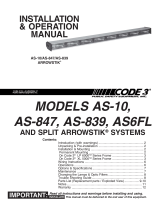
Figure 3.
a. Strip 1/4" of insulation off of each wire.
See figure 3. Use small blade screwdriver to depress spring
in connector, insert proper wire and remove screwdriver to
release spring.
b. Connect the red and black 14-gauge wires
to the connector as shown in figure 3.
c. Route the red and black 14-gauge wires
through the firewall and toward the battery. Connect the
black wire to a good frame ground near the battery. In
most vehicles, a wire from the negative terminal of the
battery is routed and attached to the body/frame at the
fender. This is a convenient point to connect the 14-gauge
black wire. Do not connect the red wire to the (+) positive
terminal at this time.
d. Connect the 18-gauge red and green wires
to the connector as shown in figure 3.
IMPORTANT
The 18-gauge red wire’s termination point deter-
mines when the directional signal can be activated.
When the wire is attached to a vehicle fuse that is
powered when the ignition switch is in the run or
start position, the vehicle’s ignition switch must be
in the run or start position to operate the directional
signal. When the wire is attached to the vehicle bat-
tery, the directional signal can be operated at any
time. Note that the unit draws no current when in
the “off” position.
e. Select the desired termination point. As
applicable, route the 18-gauge red wire toward the vehicle
fuse block or through the firewall toward the battery.
Install a user-supplied, 1-ampere, in-line fuse in the 18-
gauge red wire as close to the power source as possible and
terminate as required.
f. Route the 18-gauge green wire to a known
good chassis ground near the control. To provide a good
ground connection, scrape any painted surface to bare
metal and terminate as required.
g. Ensure that positions 5 and 6 of the six-
position connector are not used (see figure 2).
h. Plug the six-position connector into the
mating connector on the control unit, and apply pressure
until it locks into place.
2. SignalMaster Cable Connections.
a. Route the SignalMaster cable towards the
control unit, while being careful not to scrape the wires on
any sharp edges.
b. If necessary, cut the cable to the appropri-
ate length.
c. Connect six 22-gauge wires and 16-gauge
red wire to the terminal block as shown in figure 2.
Positions 1, 8, 9, and 10 are not used. Cut the unused white
and blue wires at the cable's insulating sheath.
D. Inspection and Final Installation.
1. Ensure that there are no loose wire strands or
other bare wires which may cause a short circuit. Also, all
wires must be protected from any sharp edges which could
eventually cut through the insulation.
2. Connect the remaining end of 14-gauge red
wire from the six position connector to the (+) positive
terminal of the battery with an in-line, user-supplied
fuseholder and 25A fuse. Locate the fuse as near the
battery as possible to protect the entire length of wire.
3. Read and understand paragraph IV OPERA-
TION, and test for proper operation of all functions.
4. Secure the mounting bracket to the control
unit with the 1/4-20 hex head, thread forming screws and
1/4" external tooth lock washers (see figure 1).
IV. OPERATION.
SAFETY MESSAGE TO OPERATORS
Peoples’ lives depend on your safe use of our products.
Listed below are some important safety instructions and
precautions you should follow:
• Although your warning system is operating
properly, it may not be completely effective.
People may not see or heed your warning signal.
You must recognize this fact and continue
driving cautiously.
• Also, situations may occur which obstruct your
warning signal when natural or man-made
objects are between your vehicle and others,
such as: raising your hood or trunk lid. If these
situations occur, be especially careful.
• At the start of your shift, you should ensure
that the light is securely attached and all lamps
are operating properly. The LED display on the
control only simulates the operation of the lamps.
• If a selected function does not perform properly
or if any of the lamps remain illuminated when
the control is off, disconnect the power connector
from the control unit and contact the nearest
service center.
Failure to follow these safety precautions may result in
property damage, serious injury, or death to you, to
passengers, or to others.
RETAIN AND REFER TO THIS MESSAGE
-3-












